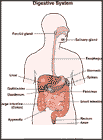
Pyloric Stenosis
Discharge Instructions
What is pyloric stenosis?
When the lower part of the stomach (called the pylorus) is too narrow for milk to pass through into the small intestine it is called pyloric stenosis. Normally, the muscle at the end of the stomach keeps food in the stomach when it contracts and lets food out of the stomach when it relaxes. In pyloric stenosis, the muscle is too big and doesn't relax well. This happens to babies between 2 weeks and 2 months of age. At first, this causes the baby to spit up often, but over the course of several days, the baby begins to vomit forcefully after nearly every feeding. This problem can be corrected with surgery.
What happens during surgery?
General anesthesia is used to put your child to sleep during the surgery. The surgeon cuts the tight muscle between the stomach and small intestine that is causing the problem. This loosens the muscle so food will be able to pass easily into the small intestine. This procedure is called a pyloromyotomy. Babies can usually eat shortly after the operation.
Will my child have any side effects from the surgery?
Children who have had the operation are usually fine after surgery. They can eat normally and start gaining weight. Over a longer period of time, their stomach should not cause them any problems as a result of the enlarged muscle or the surgery.
What are the requirements for discharge?
- _______________________________________________________
- _______________________________________________________
- _______________________________________________________
How can I take care of my child?
- Care of incisions
After surgery, your child has one or more small incisions in the upper abdomen. On the skin there are strips of tape or skin glue to help the skin heal smoothly with very little scarring. These will peel off in 5 to 10 days. Don't pull them off. Some babies may also have stitches on the skin that will be taken out by your health care provider.
Incisions that were made under the skin were closed using stitches that dissolve on their own and don't need to be removed.
- Pain control
Your child may need medicine the first few days after surgery for pain control.
Your child's pain medicine is ______________________. Give __________ every ______ hours as needed.
- Bathing
You may sponge bathe your baby after 48 hours. Keep the water level below the incisions. Once the stitches are out or the glue is off, you can bathe your child normally.
- Diet
After surgery, your baby is given increasing amounts of electrolyte solution and formula. When your child is ready to go home from the hospital, he or she can breast-feed or take formula as often and as much as he or she wants.
- Additional Instructions _______________________________________________________ _______________________________________________________ _______________________________________________________
When does my child need to be seen again?
Your child needs to be rechecked and has an appointment on ______________ at ________ o'clock with _______________________.
When should I call my child's health care provider?
Call if:
- Your child has pain that is not controlled by pain medicines.
- Your child has a fever greater than 101°F (38°C).
- Your child has any bleeding from the incision not stopped by 5 minutes of direct pressure.
- Your child has pus draining from the incision or a large red area around the incision.
- Your child has not urinated in over 12 hours.

